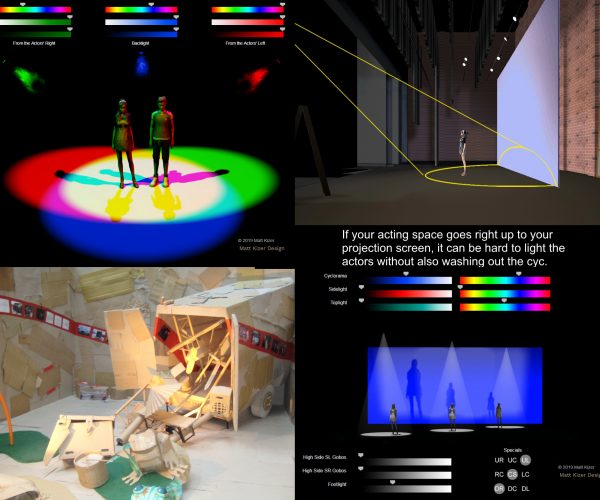The resources below are all previously published individually. Collectively, they are good material that can be applied in online learning. This list includes 43 articles and 5 different activities.
Activities
This is usually an in-class activity used with a Smart Board or a projector. It works well over Zoom meetings, though. It also works extremely well as a basis for student projects for both design and play-writing. Have students run the machine to arrive at a plot, style, and all of the other parameters, then produce a paper, a short play, or a design package that fulfills those criteria.
This is a browser-based lighting lab. It is a great way to examine how color mixes both on actors and on the floor from three directions. This works very well with shared screens over applications such as Zoom. Discuss the artistic impact of varying levels of light from different directions and color symbolism. You or your students can use the PRINT-SCREEN key on your computer to capture any image. You can then paste it into a Word document, a PowerPoint slide, or usually even an email.
This is also completely browser-based. It is a complete proscenium stage with a traditional dance-lighting plot in place. It allows complete control of color for top-light, side-light, and the cyclorama, plus footlights, high-sides, and specials.
• Gobo Lab
This browser-based light lab allows students and teachers to explore the direction and texture of lighting. Color is abandoned, leaving the designer to rely on the power of shadow and direction.
• Vintage Lighting Instruments
PAR cans, ellipsoidals, fresnels, followspots, and many other instruments have been with us for many decades. This tool explores the application and components of the traditional lighting instruments that formed the foundation of contemporary lighting.
Articles
The 42 articles listed below cover topics that include stagecraft, design, career choices, copyright law, international activities, and projections. They can each lead to further discussion, ideas, or rebuttal.
About half of them include video content, with lengths ranging from two to twelve minutes in length. You can see them all listed with sorting options here.

